
- USD/JPY analysis: US dollar remains fundamentally supported
- Dollar not so strong against other major currencies thanks to positive risk appetite
- Week ahead: RBNZ, US GDP and Core PCE all to come
Welcome to another edition of Forex Friday, a weekly report in which we highlight selected currency themes. In this week’s report, we will discuss the US dollar, with a particular focus on the USD/JPY pair, and look forward to the upcoming data releases next week
USD/JPY analysis: US dollar trades mixed ahead of US open
The US macro calendar is quiet today, which means the bulk of the focus will be once again on the technology sector and Nvidia in particular. In FX space, the USD/JPY was trading flat-ish after its recovery on Thursday stalled overnight. Other dollar pairs were trading mixed, with the greenback falling. On the one hand, FX investors were torn between bidding up commodity dollars and other risk-sensitive currencies in light of the big stock market rally. On the other, selling lower-yielding currencies in favour of the US dollar, which has been the trend so far in 2024, remained an attractive alternative. At the time of writing, the dollar was down on the week against a basket of foreign currencies, although the USD/JPY was again holding in the positive territory. FX investors were finding it difficult to justify being too aggressive in their efforts to slam the USD back down.
USD/JPY analysis: US dollar remains fundamentally supported
The underlying trend is a positive one for the dollar, especially against lower-yielding currencies like the Japanese yen. I think that the USD/JPY is poised to hit multi-decade highs in the not-too-distant future should the economy remain resilient. The US 10-year yield reached its highest level since November, at 4.354%, in the previous session, sending both the JPY and XAU lower. Gold investors would forgo this by tying up their capital in the metal than in bonds. The same reason applies to the yen, with interest rates in the negative in Japan.
Dollar not so strong against other major currencies
Against other currencies, the dollar has been struggling despite last week’s above-forecast inflation prints, as both CPI and PPI beat expectations. Profit-taking may well have been a factor behind the dollar’s weakness with some investors also finding some foreign currencies attractive in light of the big risk rally. The NZD, for example, was up for the eighth day against the greenback on Friday, ahead of the RBNZ rate decision next week. More on that below.
Still, with US data remaining mostly positive, with existing homes sales, manufacturing PMI and jobless claims all topping expectations on Thursday, the dollar bears may find it difficult to justify being overly bearish on the dollar without a change in the macro backdrop.
Meanwhile, Federal Reserve members have successfully restrained dovish sentiment, with money markets largely reducing expectations of multiple Fed cuts this year. However, they continue to assess the possibility of one or two cuts. Consequently, traders will closely monitor various data indicators next week to gauge the economy's resilience and evaluate the potential for increased inflation.
Before discussing the upcoming week’s macro highlights, let’s quickly have a look at the chart of the USD/JPY first.
USD/JPY technical analysis

Source: TradingView.com
The USD/JPY has broken out of its triangle consolidation pattern and could head sharply higher to probe liquidity above the highs of 2022 and 2023, around the 151.90-151.95 area. Short-term support was seen around 150.40 to 150.00 area. The line in the sand is at 148.93 for me, last week’s low. A move below this level would be bearish.
Week ahead: RBNZ, US GDP and Core PCE all to come
In the week ahead we will have plenty of data to look forward to from the US, which should influence the direction of the USD/JPY and other major FX pairs and gold. Among the US data highlights, we have the closely-watched PCE inflation data, the ISM manufacturing and the preliminary estimate of GDP for the fourth quarter of last year.
RBNZ rate decision
Wednesday, February 28
01:00 GMT
The RBNZ prepares for its first monetary policy decision of the year, with unexpected speculation of rate hikes by ANZ causing a stir. Despite obscurity in data, ANZ forecasts two 25bp hikes, citing concerns over uncontrolled inflation. Currently at 5.5%, the cash rate prompted a surge in the OIS curve post-ANZ announcement, now estimating around a 60% chance of a hike by May, potentially reaching 5.75%. While the RBNZ is likely to maintain rates unchanged, the focus shifts to their stance on inflation in light of ANZ's hawkish assessment. November's statement highlighted persistent high inflation, pointing to a prolonged period of restrictive rates.
US Preliminary GDP estimate
Wednesday, February 28
13:30 GMT
Despite its name, this will be the second estimate of GDP for the fourth quarter of 2023. But it often does tend to move the markets as it is usually revised, and sometimes notably so. The ‘Advance’ estimate was +3.3% on an annualised format (quarterly change x4). Let’s see if growth will be revised higher again like the previous quarter. For the dollar to weaken sharply, we will need to see a noticeable deterioration in GDP and other incoming US data. The Fed made it clear that it is in no rush to cut rates as per the minutes of its previous meeting, something which has since been echoed by hawkish rhetoric from various officials from the central bank that have spoken lately.
US Core PCE Price Index
Thursday, February 29
13:30 GMT
The most recent inflation indicators have been stronger than expected from the US, with both CPI and PPI showing price pressure remained hot at the start of the year. Those inflation gauges caused bond yields to rise, keeping the dollar supported on the dips. PCE is the Fed’s favourite measure of inflation. A hotter-than-expected print should keep the greenback supported against currencies where yields are comparatively lower (like JPY), and those where economic data is not showing much strength (like EUR). It is also worth watching the prices paid sub index of the ISM manufacturing PMI that will be released on Friday. The US dollar is likely to catch a bid should these pointers surpass expectations.
-- Written by Fawad Razaqzada, Market Analyst
Follow Fawad on Twitter @Trader_F_R





